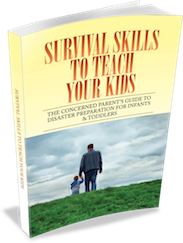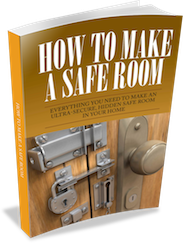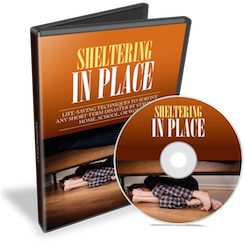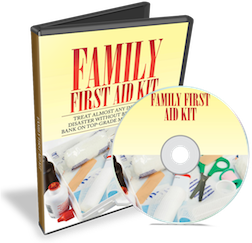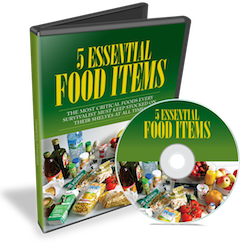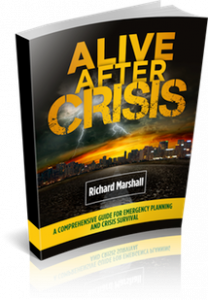
Disasters come in all shapes and sizes. For those impacted, what matters most is how you deal with it; how you react to the new reality that you must face. That, in turn, depends on how well you have prepared for it.
Alive After Crisis is your trail map through the preparation process. In it you will learn a system for disaster preparation that focuses on your basic needs, and on what you must have in order to survive, regardless of the nature of the disaster that brings crisis to your doorstep. Alive After Crisis will teach you how to prepare for disaster—any disaster—before it happens, and how to survive it when it does.
Your Special Bonus Material
A Comprehensive Guide for Building a Self-Sustained Energy System

There’s no simple solution to the problems our country faces with the electrical grid. Many years and many billions of dollars will have to be spent to restore the grid to something that we can depend on. As ordinary citizens, we can’t fix this situation for our country. The most we can do is fix it for ourselves.
Getting our homes off the grid eliminates at least part of our dependency upon a failing system which isn’t being updated fast enough. If we can produce even a fraction of the electrical power we’re consuming each month, then when the grid goes down we won’t have to go down with it.
Producing only 20 percent of your monthly electrical needs can make a huge difference in your monthly expenses. As energy costs go up, that difference will increase even more. So, investing money in getting off the grid doesn’t make sense just from an emergency preparedness point of view, but it makes sense from a basic financial point of view as well.
Having trouble? Click here for help downloading and opening the eBook…
A Comprehensive Guide for Storing, Filtering, and Purifying Water in a Crisis

Safe, potable, drinkable. They all mean pretty much the same thing: plain old water, with nothing else in it that will make you sick or kill you when you drink it. You have to have it, and, depending on the nature and the duration of the crisis that you face, you will need to have a continuing, reliable source for it.
The Water Crisis Survival System will show you exactly what you need to do in order to collect, store, filter, and purify water in a crisis. And you’ll learn the best ways to find a water supply when the taps have gone dry and there’s nothing left in your storage containers. Water is life, so pay close attention because your survival could depend upon it.
Having trouble? Click here for help downloading and opening the eBook…
Welcome to the United Survivalists Association
Bug-out Bag Essentials
Bug out bags, as a common rule of thumb, are meant to keep you alive for 72 hours. Of course, you can always attempt to put them together to last longer, but you’ll want to avoid adding too much weight.
That makes deciding exactly what to store in your bug out bag a little tricky – it’s all about choosing what you’ll really need to have, since space (and weight) is a precious commodity when it comes to your bug out bag. So no matter what you put in your bag, keep in mind how much space and weight it is taking up and always look for more efficient options without cutting corners.
It’s also important to note that not everyone’s bug out bag is going to look the same. Each individual or group has their own needs when it comes to what will keep them alive for 72 hours. Here, we’ll explore some essentials to consider as you decide what to include in your bug out bag.
Sustenance
When planning on staying alive for 72 hours, the first things that should come to mind are food and water. Depending on your contingency plan, you may need to carry plenty of it.
Make sure to have enough water to last until you locate an appropriate water source (lake/river). Most bug out bags and assault packs come with a slot in the front for hydration systems (Camelbak/Hydrapak). While using this slot has an advantage, you may find that putting a hydration system there may make wearing your bug out bag a bit uncomfortable, which is an added distraction you don’t want in a survival situation.
As far as food goes, you’ll want lightweight non perishable items. While canned foods have their advantages when food stockpiling (where weight isn’t a concern) you may find that they’re not such a good idea for bugging out. Luckily, many things that are available in canned form are commonly available in pouches as well. Other things to add are dry foods and dehydrated foods.
You’ll want to consider the possibility of being in a survival situation longer than the supplies in your bug out system will last. Therefore, it is wise to plan on procuring food by means of hunting, trapping, fishing, and finding edible plants. This is where prepping by gaining knowledge and skills comes into play.
Health & Safety
Including items for health and safety in your bug out bag is one of main areas where it’s easy to go overboard. The key to keeping your bag weight down is to carefully consider only what you’ll need for survival for 3 days. The necessary items can be drastically different for everyone.
For example, if you’re in need of any daily medications for health reasons, you’ll need to be sure to include at least a 3-day supply of those in your bug out bag. If you have a condition like asthma or any allergies, you’ll need to pack an emergency inhaler and/or an epi pen.
Every bug out bag needs some type of water purification method. In an emergency situation, the last thing you’ll need is to become sick from drinking tainted or impure water. You need water to stay alive, but it’s much too heavy to include a 3 day supply in your bug out bag. Instead, carry a full flask or canteen (which can be refilled as you’re able to find water). Choose a heavy duty stainless steel water bottle that can be used to boil water and make it safe for drinking.
You can also find canteens and water bottles that have a built in filtration system. These types of containers are very handy if you come across a clean water source, but you may not want to rely on that possibility in a bug out situation – consider your area and the resources available along your “bug out pathway” when deciding. A stainless steel/filtered combo would be a good solution – filter water when you can find a decent source to save time and boil it when you have to.
First aid supplies are also important, for obvious reasons. The key here is just as much what not to do as anything. Many beginning preppers pack any first aid supplies they can get their hands on thinking that variety will save them and cover all their bases. The reality is, first aid supplies with little realistic value just add useless weight to your bug out bag – not good. Also important to note is that first aid supplies (or any supplies for that matter) that you don’t actually know how to use are useless.
For this reason, it’s strongly advised that you assemble your own first aid kit “from scratch” rather than buying a premade kit. The kits you can buy often have low-quality items that you will probably never need and too few of what is genuinely useful.
A good starting point is to consider items that are quite “basic” in nature – many of these will have more than one use and don’t require a lot of know-how for use on the fly (when you’ll need them.)
- Cloth bandages. These can be used to dress wounds and also to care for minor sprains.
- Basic medicines. Simple medicines that can be used to treat pain and illness are wonderful to have on hand in a bug out situation. Think ibuprofen, antibiotics, and the like.
- Medical tape. Enough said – there plenty of uses beyond the obvious, so it’s great to have.
- Gauze wrapping. Ideal for dressing wounds, as it’s the most sanitary option to have available.
- Bandaids. This is just a simple, lightweight item that you might as well pack to be able to dress minor wounds.
- Antiseptic. Another wound care item you’ll want to be sure to have on hand is something you can put on your wounds to fight infection and promote healing. You can pack an over the counter ointment or a small bottle of tea tree essential oil for this purpose.
- Q-tips and cotton balls. These, again, are so lightweight that you might as well pack them – they are a more sanitary tool to use than anything you’ll be able to find for medical care.
- Tweezers. Pull out debris from wounds to fight infection – you’ll be surprised at how often a tweezers comes in handy.
- Sun block. You might be travelling in more direct sunlight than your skin is used to, so prevent sunburn by packing some sort of protection. A severe sunburn can be debilitating as you attempt to travel to your bug out location.
- While a more extensive certainly can and should be put together for storage at your bug out location (and in your home, for that matter), these basics will cover most of what you’ll come across in 3 days time.
Don’t underestimate the importance of bandages – a variety of sizes will serve well, and you might as well pack them since they are light weight. Many people (understandably) don’t always dress wounds properly (or even at all for minor wounds) in their day to day life but this practice absolutely cannot carry over into a bug out situation as the risk for infection is going to be much greater. Infection is no small matter, either – they can spread all over the body and make you seriously ill, or at the very worst – be fatal. Learn to care for wounds properly and be sure to do so if you ever find yourself bugging out. Pay especially close attention if you find yourself dressing a wound on your feet as these are particularly vulnerable to infection, which can quickly leave a person pretty much disabled.
Another important item to include in your bug out bag is a dry change of clothes. Include all the basics – a clean, dry shirt, pants, underwear, and socks – perhaps even 2 or 3 pairs of socks depending on your situation. Your clothes are likely to get wet and sleeping in wet clothes can lead to hypothermia. Don’t sleep in wet clothes! If your clothes do become wet, change into the dry ones you have before sleeping and hang the wet ones to dry near your fire as you rest.
Shelter is also an important consideration. You should be able to find a tent that suits your needs without adding too much carry weight – if nothing else, an erected tarp will do. Either way, be sure to pack a ground tarp as well to keep the ground where you sleep dry. You’ll also want to carry a blanket to stay warm – a sleeping bag is obviously ideal. The weight of your blanket will depend on your climate but you’ll want something that rolls as small as possible for easy carrying. One that is easy to clean is also a bonus.
Tools
There is a wide array of tools available to you to use in survival situations and what you choose will depend upon your contingency plan. Where a hatchet will come in handy for one person, a hacksaw will be better for another. Overall, here a few things to keep in mind:
- Multi-tool – A good multi-tool (Gerber/Leatherman) will go a long ways towards your self reliance, survival scenario or not. When choosing an appropriate one, look for durability and versatility.
- Folding Knife – You don’t have to go far before finding yourself in need of an easily accessible knife. Luckily, high quality folding knives are readily available in a multitude of shapes and sizes from various manufacturers (Benchmade/Spyderco). Finding one that suits you best may take some time, but won’t be very difficult.
- Survival Knife – In any bug out scenario, you may find yourself in a situation that calls for more than your folding knife can handle. When looking at options, it is preferable to have one with a blade length of at least 4-5 inches. Also, some of the highest performing knives also happen to be amongst the least expensive (Cold Steel G.I. Tanto, Light My Fire Swedish Fireknife).
- Flashlight – Having a flashlight on hand during a survival situation is highly recommended for not only being able to see what you are doing at night, but also for signaling. A good idea is to have a hand crank flashlight as well as a battery operated one. While the battery operated flashlight has more capabilities, a hand crank model will allow for more longevity.
- Rope – Paracord is a great option and should serve well in most situations. You may need rope for a variety of purposes, such as climbing, erecting shelter, or hauling firewood. A ton of uses and low carry weight make it a no brainer.
- Waterproof matches – You need to be able to start a fire to cook food, boil water, stay warm, and keep predatory animals away. Waterproof matches are another must have. Consider carrying petroleum jelly to aid in your fire-starting speed and capability as well.
Defensive Measures
When you’re in a high stress survival situation, you can’t always count on the general kindness of other human beings. It is an intelligent plan to have some form of self defense at hand. The most common defensive measure would be to carry a gun. If this is a measure that seems more suitable to you, you may wish to ensure that it is concealed. An open carried weapon may fend off an attacker without the need to openly threaten its use, but it will also attract unwanted attention; whether it be from someone who thinks you are a law enforcement official or someone who wants to take your gun from you.
While carrying a pistol would seem the most obvious weapon to carry, you might consider carrying a compact rifle such as a Ruger 10-22 instead. It may serve as a defensive measure as well as a legitimate way to gather more food for you and your family.
Some other defensive measures you should take into consideration are what clothing you wear. You’ll want to wear clothing that is capable of defending against the natural environment. Go with layers to add warmth as well as versatility.
Some “experts” promote military style clothing such as ACU’s for bugout scenarios. Doing so would be a big mistake. Whatever you do, avoid any and all clothing that makes you look official. It will attract people who either A – want you to keep them alive or B – want the supplies you possess. Instead, avoid bright colors and anything that might be mistaken for a uniform.
A Word on Fitness
Maybe it goes without saying, but carry weight is everything when it comes to putting together a bug out bag that works for you. If it’s too heavy, you’re not going to get very far as you attempt to bug out. This is where fitness comes into play, as well. Even if your bug out bag is well within a reasonable weight, it has to work for you to be effective. Another means of preparation in light of this insight is to keep your body prepared, as well. If you’re out of shape, you probably won’t make it too far as you try to bug out no matter how light your pack is. Hiking is hard. Exercise regularly and carry heavy items often – seek to always be improving both your strength and your endurance. These two traits will serve you incredibly well in life – especially if you find yourself bugging out.
A Complete Bug Out Bag
Many preppers make the mistake of trying to put together a bug out bag that they can basically live out of. While it’s certainly a worthwhile goal, it’s also pretty unattainable and misses the mark on what the ideal should be for a complete bug out bag. A bug out bag is meant to get you from point A – your current location, which you’re fleeing from for whatever reason arises – to point B – your predetermined, safe bug out location. You don’t need to include any item you can think of to keep you alive for years on end – you’d need a pretty big bag and more strength than is typical for a single person to pull that off.
When you are trying to decide whether your bug out bag is “done” – consider the planned route to your bug out location and ask yourself a few questions while keeping the supplies you have included in mind.
- Will I… be able to eat? Do I have food and a way to cook?
- Will I… be able to drink? Do I have means for collecting and purifying water?
- Will I… stay warm? Do I have what I need to create shelter and a dry set of clothes? Am I able to make a fire?
- Will I… be able to perform basic medical care? Can I dress wounds, sprains, and bone breaks?
- Will I… be able to protect myself? Do I have a weapon that’s going to be effective for protection against vicious animals and/or hostile enemies?
- Will I… find my way? Do I have what I need to get to my bug out location on schedule, without getting lost?
By considering these questions, you’ll be able to patch any gaps in you bug out supplies.
Bugging Out as A Group
Bugging out with others comes with both challenges and advantages. For example, while a group tends to move more slowly than a single person, there is safety in numbers. Having others you trust with you means
- Caring for each other medically when necessary.
- A wider variety of skills to benefit the group.
- Greater protection from hostile enemies.
- More able bodied individuals to carry supplies.
Touching on the last point, if your bug out plan includes a group, you’ll want to collaborate to determine what supplies everyone will have in their own bug out bag. There are basics that everyone will want to have their own of, but with proper planning more variety among your group can be a great benefit. Planning is key, though – the last thing you would want is to find that everyone has packed cloth bandages, but no one has any matches.
